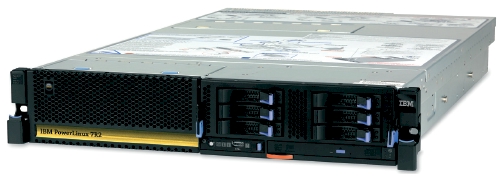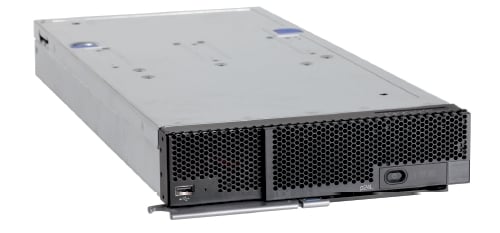Original URL: https://www.theregister.com/2012/04/23/ibm_powerlinux_servers/
IBM fires Power-powered Penguins at x86's weak spots
Linux-only servers to gobble piece of a $10bn pie
Posted in OSes, 23rd April 2012 10:42 GMT
Big Blue has not made any huge proclamations to date, but it is not exactly a secret that the people in charge of IBM's Systems and Software Group want the Power7 processor and its follow-ons to grab a larger share of the systems racket.
To that end, Big Blue is reviving a Linux-only variant of its Power Systems lineup with cheaper hardware and software pricing that it says gives better value on Linux workloads than an x86 setup.
The new machines, part of what will eventually be a family branded PowerLinux, are variants of existing iron that run in bare metal or virtualized mode using IBM's homegrown PowerVM hypervisor, and which have settings in their firmware that only allow Linux to boot on the machines.
That's right: the firmware prevents IBM's own AIX Unix variant and IBM i proprietary operating systems from booting, Scott Handy, vice president of PowerLinux strategy and business development, tells El Reg.
This may be a counterintuitive move, making your iron and hypervisor cheaper running someone else's operating system, but this is not the first time IBM has done such a thing, and it's a strategy that has had a certain amount of success.
The idea, explains Handy, is not to take on x86 servers in all markets and price bands, which is not even possible since IBM's Power processors do not support Microsoft's Windows Server operating system. Way back in the day, the PowerPC 6XX processors did run Windows NT 3.51 for a brief somewhat shining moment, and of course Microsoft's Power-based game consoles run a variant of the Windows OS, too.
So it is not technically impossible for Windows Server to come to Power7 chips. It is just politically and economically impossible. The best move on Big Blue's part is to find areas where the x86 platform is weak and make the Power7-based systems competitive for these specific workloads.
IBM has done a pretty remarkable job unseating Sun Microsystems and Hewlett-Packard in the Unix server racket with Power-based machines, but this market is shrinking, not growing. And by chasing Linux-on-x86 with Power-based iron, Big Blue bags another $10bn revenue opportunity.
Handy says that of the 1.6 million or so servers that will be sold to run Linux in 2012, three-quarters will be two-socket boxes. And unless IBM does something, most of them will be Xeon machines with a smattering of Opterons.
"We stepped back and looked at the buying behavior of these Linux customers, which is different," Handy explained. "First off, we need to take price off the table and price comparably to the x86 server," he admitted, and then he said IBM had to be careful that whatever it did with the PowerLinux machines did not undermine sales of Power Systems machines running AIX or IBM i sales. "These are all designed to get incremental business for us."
AIX and IBM i customers will no doubt be a bit miffed, since Linux customers will be getting a better deal on both the hardware and the PowerVM hypervisor, which is also having its price chopped for PowerLinux machines. Exactly how much IBM is cutting pricing on the Power servers and the PowerVM hypervisor was not divulged ahead the launch, which is official on Tuesday, but IBM is talking about it today. If it is like prior IBM announcements, pricing has not actually been finalized yet.

The PowerLinux 72R server from IBM
IBM was able to do some fast talking with Red Hat and even managed to get Shadowman to make the pricing of its Enterprise Linux the same on the two-socket PowerLinux boxes as it charges on two-socket x86 boxes.
Red Hat charges $799 for a standard subscription on two-socket servers built with Xeon or Opteron processors; if you want to use the built-in KVM or Xen hypervisors, then you have to pay $1,199 to support up to four guest virtual machines and $1,999 for unlimited guests. If you want premium 24x7 support, raise that price by 62.5 per cent.
On two-socket Power-based machines, RHEL support costs $2,700 for a standard subscription and $4,300 for a premium subscription; this license is enabled for a maximum of 15 logical partitions using IBM's PowerVM hypervisor.
This is an apples-to-oranges comparison, but being generous Red Hat is charging at least a 35 per cent premium on Power-based machines with two processor sockets. Shadowman charges around the same premium on four-socket Power machines, too, and on mainframes, you pay $15,000 per core for one year of standard support on a System z box.
Handy says that SUSE Linux, the unit of Attachmate that now owns the other major commercial Linux distro, has not tweaked its pricing for the PowerLinux boxes and will "see how it goes". A standard support contract for SUSE Linux Enterprise Server will run you $799 per x86 server, and SUSE Linux doesn't care how many VM partitions you run it on or how many sockets are in the box. Priority support costs $1,499 per box.
Pricing for Power and Itanium iron servers for SLES support is based on per socket fees, with standard support running $850 per socket and premium support running $1,000 per socket. Red Hat does not support Itanium with RHEL 6, but does with RHEL 5. And while SUSE Linux no longer publishes its mainframe prices, they were the same as Red Hat's for many years and there is no reason to believe they have changed.
The two PowerLinux machines announced today can be equipped with RHEL 5.7 and 6.2 and SLES 10 SP4 and SLES 11 SP2.
Same iron, different firmware and pricing
There are two different PowerLinux machines that IBM is bringing out today, and Handy says that there are "three more coming right behind these". They are based on existing Power7-based servers.
The first machine is the PowerLinux 72R server, a 2U rack-mounted box that can be equipped with an eight-core Power7 processor running at either 3.3GHz or 3.55GHz. The latest Xeon E5-2600 processors from Intel have eight cores as well, but only two threads per core compared to four threads with the Power7 chips. This matters for thread-hungry jobs, such as Java application servers and virtual machines and databases, just to name two.
The machine is configured with a base 8GB of DDR3 memory, expandable to 256GB, and has room for six disk or SSD drives. It also has five PCI-Express 2.0 x8 slots and four Gigabit Ethernet ports. The latest Xeon E5-2600 processors support PCI-Express 3.0 slots and also offer 10 Gigabit Ethernet ports on the motherboard in a lot of server designs, and for a lot of workloads (database clustering or parallel supercomputing, for example) this will matter.
This PowerLinux 72R machine is based on the Power 730 server that Big Blue rolled out in August 2010 and then enhanced last October.

IBM's PowerLinux FlexSystem p24L server node
The second server is the Flex System p240L, which is electronically identical to the Flex System p260 server that IBM announced two weeks ago as part of its PureSystems converged and cloudy boxes. Again, the firmware in this half-width server node does not allow it to run AIX or IBM i.
The p240L can be equipped with a six-core Power7 chip running at 3.7GHz or an eight-core chip running at either 3.2GHz or 3.5GHz. It is a two-socket box, like the PowerLinux 72R, and comes either one or two processors installed.
This server node has 16 DDR3 memory slots and supports up to 256GB of memory across those two processors. It also includes two internal 2.5-inch disk or 1.8-inch SSD bays that are attached to the node lid and that tuck into the space above the main memory on the system board. There wasn't room to put the drives in the front as IBM does with its Flex System x240 server nodes for the PureSystems machines, which are based on the Xeon E5-2600 processors.
The p24L node has two PCI-Express x8 slots and two mezzanine cards that hook into the midplane on the Flex System chassis and deliver InfiniBand, Ethernet, and Fibre Channel connectivity at various speeds to the server node.
For a comparable setup for running virtualized server instances, Handy says that four PowerLinux 72R servers with the 3.55GHz Power7 chips running RHEL 6 and PowerVM 2.2 will be able to do the work of five HP DL380 G8 servers using Intel's 2.4GHz Xeon-2665 processor with RHEL 6 and VMware's vSphere 5.0 Enterprise virtualization stack. They will also be able to do so at a 33 per cent lower total cost of acquisition over three years. HyperThreading and SMT were both enabled on both machines, by the way.
As far as targets go, the PowerLinux machines are aimed at three of them. First, companies that mainly used the apps that are built into the RHEL and SLES distributions, which is a little more than half of the enterprise Linux shops out there in the world, according to Handy.
The other target is customers who want to run applications stacks like SAP on top of Linux. Oracle doesn't support its 11g R2 database on Power processors running Linux (it does on AIX), so this could be a problem for some shops that have standardized on Oracle databases. IBM's DB2 will run on PowerLinux machines, as will EnterpriseDB's variant of the PostgreSQL database.
And the final target is big data, of course. IBM has ported its InfoSphere Streams streaming server to the PowerLinux machines, and will have its InfoSphere BigInsights distribution of Hadoop running on the machines by June 15.
The cut-price PowerVM for PowerLinux hypervisor offers micropartitioning, which allows each core in the box to have as many as 10 logical partitions as well as the Virtual I/O Server virtualized disk and optical drive server, active memory sharing across partitions, live partition mobility between physical machines, and other features commonly bundled in the top-end PowerVM Enterprise Edition hypervisor for regular Power Systems machines.
IBM first sold cut-priced Linux-only Power servers back in September 2004 with the OpenPower 720, a four-socket machine based on dual-core Power5 processors and also sporting RHEL or SLES. The following spring, IBM put out a two-socket machine called the OpenPower 710. IBM has also dabbled off and on with Linux-only mainframes, the last of which were announced back in December 2009. ®